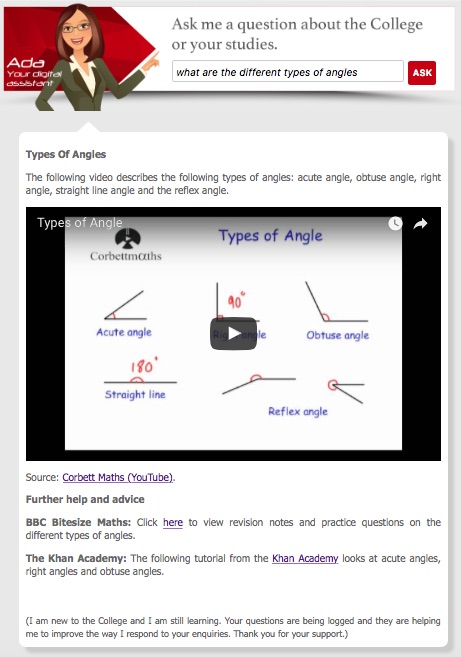Ada in the Classroom
Introduction
Following on from the launch of Ada, Bolton College's digital assistant for students and teachers, work has continued to improve the way Ada responds to a wide range of questions. Ada is able to respond to student questions across three broad categories. Namely:
-
General enquiries from students about the College (what are the semester dates, what are the library opening hours, how do I find the exams office and more);
-
Specific enquiries from students about their studies (what lessons do I have today/this afternoon/tomorrow, who are my teachers, what’s my attendance like, when is my next exam, when and where is my work placement and more); and
-
Subject specific enquiries from students (we are teaching Ada to respond to questions relating to GCSE Maths, GCSE English and the employability curriculum).
Ada in the Classroom
One of the most interesting aspects about developing a digital assistant for students and teachers has been the potential for the service to support and enhance teaching, learning and assessment. The learning technology team at Bolton College has conducted research to enable the delivery of the following services through Ada:
-
the ability to deliver personalised, contextualised, differentiated and adaptive learning and assessment materials to each student;
-
the ability to utilise particular elements of the student dataset to deliver personalised learning to each student. Ada's responses to student questions can be informed by multiple variables such as the academic level of the student, the current performance of the student on the course, student assessment data, the vocational setting of the student, the goals and targets associated with each student and more.
This represents a significant milestone for the ILT team because it means that teachers across Bolton College can offer differentiated and adaptive teaching, learning and assessment materials to the student via Ada as well as Moodle, the College's virtual learning environment.
Ada Maths
One of the early milestones that has been achieved is Ada's ability to respond to student enquiries about any topic in the GCSE Maths curriculum. In the following example Ada responds to a question relating to 'types of angles'. The reply that is presented to the student includes videos and links to external resources. These replies can adapt to suit the needs of each student. For example, if a student is doing well in the subject Ada can present stretch and challenge materials to the student. Where a student is struggling with the subject Ada can present materials that reflect the academic needs of the student.

One of the advantages for Bolton College's Maths Team is the ability to monitor the types of questions that are being asked by students from across the College. For example, if multiple students start asking Ada about ratios, the Maths Team can arrange a dedicated workshop on the topic. With this information, teachers are better placed to support students when in face-to-face lessons.
How do digital assistants fit alongside virtual learning environments?
The advent of the digital assistant in an education setting means that students have an opportunity to access another channel to garner adaptive and personalised learning and assessment materials when they are inside or outside the classroom; and when they are away from the traditional virtual learning environment. The dominance of the virtual learning environment or the learning management system for delivering teaching, learning and assessment materials has reached an end; especially when the digital assistant can answer questions and actions such as: when is my next assignment due in, I want to hand in my assignment, what grade did I get for my last assignment, has my teacher posted anything for my attention, are there any resources on topic x and so on. In coming years I hope that companies that offer virtual learning environments, adaptive learning environments or learning management systems to the education sector will take advantage of natural language processing, natural language generation and natural language understanding to offer digital assistants that are integrated to their wider platforms.